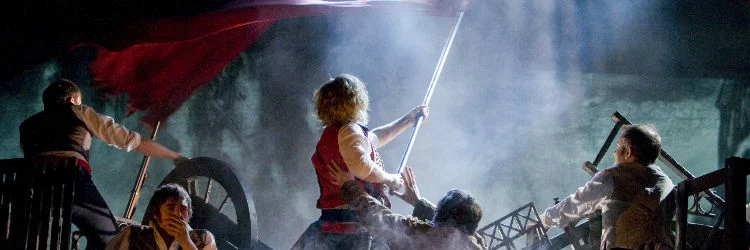
Les Miserables: Making a new version of the West End's longest-running musical in history
Early on in the producing career of Cameron Mackintosh, he opened an original musical called The Card. In an introduction to the published lyrics of the legendary Alan Jay Lerner, Mackintosh recalls a conversation he had with Lerner after it opened. Lerner asked him how it was going; and Mackintosh remembers replying, "Not bad, but the problem was some weeks it made a little money, and other weeks it lost money." Lerner answered: "Ah, a succès d'estime - a success that runs out of steam."
Momentum remains the most important factor in establishing a hit show - and maintaining it. In a 2010 interview with Mackintosh in the Financial Times, he admitted that the success of Les Miserables was by no means assured: "Les Mis was thought to be too highbrow, it had a title no one could pronounce, it was the RSC, and so on. All the publicity was about how dreary it was.' It was dubbed "The Glums" by Jack Tinker, the leading critic of his day in the Daily Mail, with his review stating, "Despite the grandeur of the music, the courage of the intentions, Les Misérables has, sadly, been reduced to The Glums"; while Lyn Gardner, then writing for a weekly listings magazine called City Limits, dismissed it as "a load of sentimental old tosh," and advising: "If I was the RSC I'd forget about a West End transfer and settle for a made-for-TV American mini-series".
In Edward Behr's comprehensive history of the original production, The Complete Book of Les Miserables, he tells the story of how Mackintosh agonised about whether to exercise that transfer option to the Palace Theatre. As John Caird, co-director of the original production, put it to Behr, "Cameron went through forty-eight hours of gloom. He really was knocked sideways by the adverse critical response." Mackintosh picks up the story of what he was faced with: "I only had 48 hours to make the crucial decision whether to go ahead and risk losing another £300,000 - which was what the transfer from the Barbican to the Palace would cost. I had already put down a non-refundable £50,000 for my pontoon on the Palace. I asked for more time but this was refused. If I had said no, as many people wanted me to, the career of Les Miserables would have ended there and then after its Barbican run. I would have lost the possibility of the Palace Theatre - and the future of Les Miserables - for ever."
With Mackintosh faced with making the decision, he called the Barbican box office. As he recalls it, he was told by them, 'I'm amazed you got through. The phones haven't stopped ringing. We've sold a record 5000 tickets already." The transfer would go ahead after all. As Mackintosh also told the FT in 2010, "It took four weeks for the Thursday matinee to go solid. Once it went solid, you couldn't get a ticket for years. It was a miracle."
What sold the show ultimately was word-of-mouth. As Mackintosh also remarked the FT, "You smelt that the public had embraced it." And 35 years later, that's still the case - "More than ever. Because a huge number of people just don't read newspapers any more."
It not only quickly became a phenomenon - like The Phantom of the Opera, on which Mackintosh joined forces with composer Andrew Lloyd Webber to premiere in the West End less than a year after Les Miserables - and soon replicated its success on Broadway, and subsequently around the world.
In a 2016 interview, again in the FT, it was noted, "The 68 backers (including one large syndicate) who put up £600,000 for the original London production of Les Misérables in 1985 have made £47 million to date - 78 times their money - and are still earning." Those figures will be even higher now.
Mackintosh also made an important decision early on that has paid even richer dividends, literally, on the show's global journey. "When I did Les Mis I said, 'I'm not going to take this on the road unless it's as good as what people have read about, with the same lighting and the same sound.''I think that's my biggest bequest - that I imposed my standards. It's sensible, actually, because the real thing will last longer than something shoddy."
It is part of that philosophy that has led him to reinvent the show anew for a new generation now. When Les Miserables officially re-opens at the newly re-named Sondheim Theatre (formerly the Queen's), it is not just the theatre that has been entirely refurbished and rebuilt, but also Les Miserables itself, in the overhauled 2010 touring production that previously came to the Barbican Theatre ten years ago, to celebrate its 25th anniversary.
I reviewed that production at the time, and said: "But while you can take the RSC out of the Barbican, a building they vacated some years ago, can you take the RSC out of Les Miserables? That has finally happened in this new incarnation, first launched as a more streamlined touring version of the show at Cardiff. It has been restaged by former Les Mis cast members turned directors Laurence Connor and James Powell, and redesigned by scenic and image designer Matt Kinley, who had been an associate to original designer John Napier on previous incarnations of the show on Broadway and in Holland. Those are not the only connections to the previous production. Andreane Neofitou's costumes are also recreated... So there's a sense of some continuity, but also significant changes, not least to its physical scale, with beautiful painterly projections (inspired by Victor Hugo's own paintings) replacing some of the larger setpieces - the epic revolve, in particular, has gone. Instead, the show comes with a new propulsive momentum, uninterrupted by lumbering set changes. That usefully refocuses the emphasis on the narrative rather than the spectacle."
It didn't come without some pushback, particularly from the original creative team including co-directors Trevor Nunn and John Caird, and designer John Napier. As Nunn commented at the time, "There is no point beating about the bush. We are profoundly unhappy and feel profoundly betrayed." More recently, Napier told The Stage in an interview last February, "I have made an enormous amount of money from these three Cameron Mackintosh productions [Les Miserables, Miss Saigon and Cats] over the years, but clearly there was something going on in Cameron's mind where he was not satisfied with what we did originally on Les Mis. And once again he "turned it into sort of another Oliver!"
He's referring to Mackintosh's similar overhaul of that show, which he commented made them "formulaic as opposed to out-of-the-box and radical. My grief about that, if there is such a thing as grief with someone tinkering with a show, it is that it led Les Mis down a path that felt a bit backwards, into some sort of era of stage cloths and people pushing things on from left and right. The thing about the original is that it's much simpler and more organic than the other production."
But when I interviewed co-director Laurence Connor in 2017, he said they were sensitive to some of those concerns, but he added: "Cameron's point was that these shows were never created to run like this. The show was too good to be allowed to get stale, and 25 years on would be the right time to look at it afresh."
And here we are now, 35 years since the original production opened in London, and the public are being invited to see the show again with fresh eyes (and ears). So, too, are the critics; and I'll be heading back to see it once again. Watch this site for my fresh take on this fresh take!
Frequently asked questions
What is Les Misérables about?
Do you hear the people sing? The iconic West End classic returns with a fresh staging and design. Even if you’ve seen Les Mis before, you haven’t seen it like this. This global hit tells a timeless story of redemption and revolution, complete with famous songs like “I Dreamed A Dream.” Get your tickets to Les Miserables at the Sondheim Theatre today.
How long is Les Misérables?
The running time of Les Misérables is 2hr 50min. Incl. 15min interval.
Where is Les Misérables playing?
Les Misérables is playing at Sondheim Theatre. The theatre is located at 51 Shaftesbury Avenue, London, W1D 6BA.
What's the age requirement for Les Misérables?
The recommended age for Les Misérables is Ages 7+. Children under the age of 16 must be accompanied by and sat next to an adult ticketholder (18+). Children under the age of 3 will not be admitted..
How do you book tickets for Les Misérables?
Book tickets for Les Misérables on London Theatre.
What are the songs in 'Les Misérables'?
Les Misérables is a sung-through musical featuring many classic songs like “Bring Him Home,” “Stars,” and “I Dreamed a Dream.” Read our complete guide to the songs in Les Misérables.
Who wrote 'Les Misérables'?
Les Misérables is an adaptation of Victor Hugo’s novel. The musical was written by Claude-Michel Schönberg (music) and Alain Boublil (French lyrics), with Herbert Kretzmer providing the English-language libretto.
Who directed 'Les Misérables'?
Trevor Nunn and John Caird directed Les Misérables on stage, and the duo won a Tony Award for their work on the show in 1987.
When did 'Les Misérables' open in the West End?
Les Misérables opened at the Barbican Centre on 8 October 1985, then transferred to the Palace Theatre on 4 December 1985. It later moved again to its current home at the Sondheim Theatre on 3 April 2004.
Is 'Les Misérables' appropriate for kids?
This production is suitable for children over the age of 7. An adult must accompany any children under 16, and children under 3 will not be admitted into the auditorium.
Is 'Les Misérables' good?
An epic spectacle, Les Misérables continues to leave audiences breathless after over thirty years with its beautiful score and captivating story. Read our five-star review of Les Misérables.
Is 'Les Misérables' a true story?
Whilst Les Misérables is an adaptation of Victor Hugo’s novel of the same name, this fictional work dives into the inequalities of 19th-century France, including the June Rebellion of 1832.
Is 'Les Misérables' an opera?
No, Les Misérables is not opera but is categorised as a sung-through musical. The show seamlessly weaves spoken dialogue with various musical styles to tell the story. Find out more about the songs in Les Misérables with our song guide here.
Originally published on









